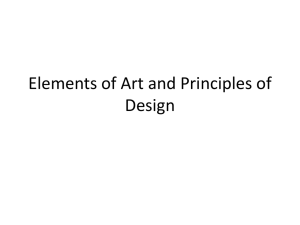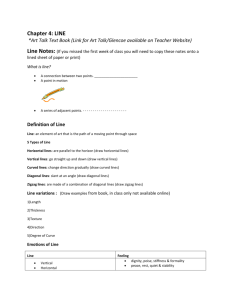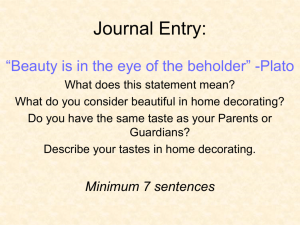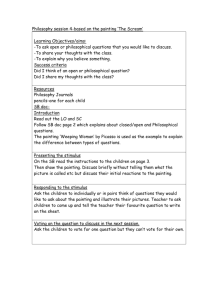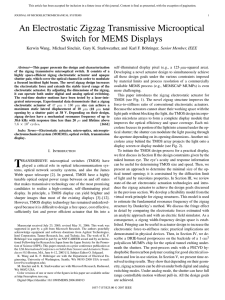Line
advertisement
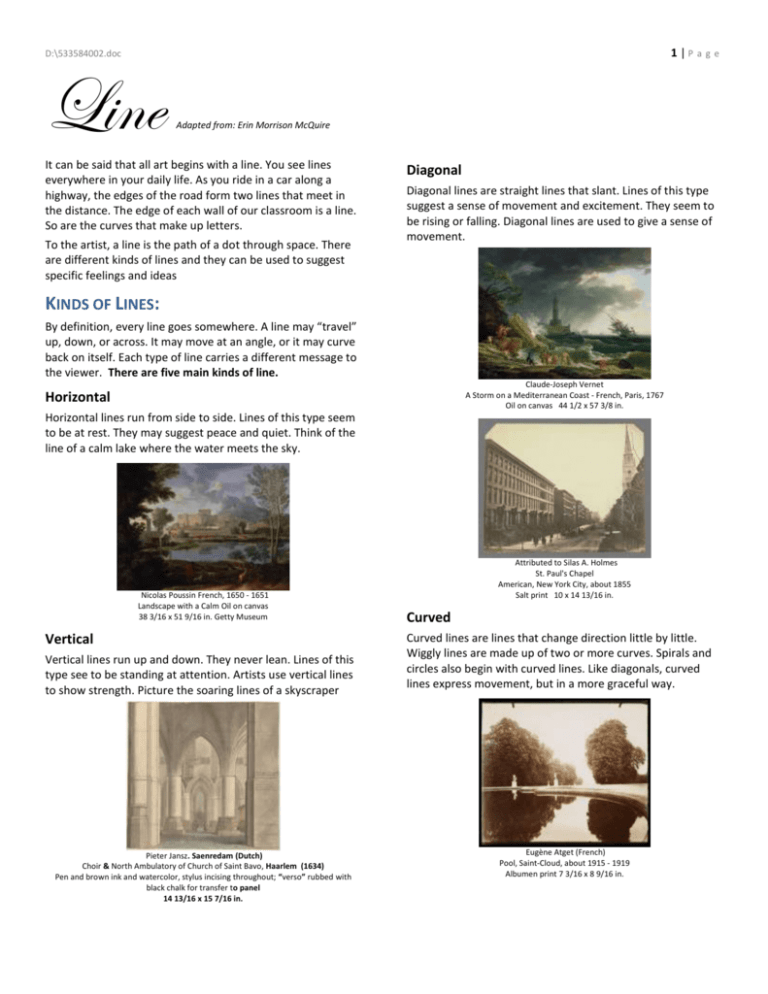
1|P a g e D:\533584002.doc Line Adapted from: Erin Morrison McQuire It can be said that all art begins with a line. You see lines everywhere in your daily life. As you ride in a car along a highway, the edges of the road form two lines that meet in the distance. The edge of each wall of our classroom is a line. So are the curves that make up letters. To the artist, a line is the path of a dot through space. There are different kinds of lines and they can be used to suggest specific feelings and ideas Diagonal Diagonal lines are straight lines that slant. Lines of this type suggest a sense of movement and excitement. They seem to be rising or falling. Diagonal lines are used to give a sense of movement. KINDS OF LINES: By definition, every line goes somewhere. A line may “travel” up, down, or across. It may move at an angle, or it may curve back on itself. Each type of line carries a different message to the viewer. There are five main kinds of line. Claude-Joseph Vernet A Storm on a Mediterranean Coast - French, Paris, 1767 Oil on canvas 44 1/2 x 57 3/8 in. Horizontal Horizontal lines run from side to side. Lines of this type seem to be at rest. They may suggest peace and quiet. Think of the line of a calm lake where the water meets the sky. Nicolas Poussin French, 1650 - 1651 Landscape with a Calm Oil on canvas 38 3/16 x 51 9/16 in. Getty Museum Vertical Vertical lines run up and down. They never lean. Lines of this type see to be standing at attention. Artists use vertical lines to show strength. Picture the soaring lines of a skyscraper Pieter Jansz. Saenredam (Dutch) Choir & North Ambulatory of Church of Saint Bavo, Haarlem (1634) Pen and brown ink and watercolor, stylus incising throughout; “verso” rubbed with black chalk for transfer to panel 14 13/16 x 15 7/16 in. Attributed to Silas A. Holmes St. Paul's Chapel American, New York City, about 1855 Salt print 10 x 14 13/16 in. Curved Curved lines are lines that change direction little by little. Wiggly lines are made up of two or more curves. Spirals and circles also begin with curved lines. Like diagonals, curved lines express movement, but in a more graceful way. Eugène Atget (French) Pool, Saint-Cloud, about 1915 - 1919 Albumen print 7 3/16 x 8 9/16 in. 2|P a g e D:\533584002.doc Zigzag LINE QUALITY: Zigzag lines are formed by joining together several diagonals that move in different directions. The diagonals form sharp angles that change direction suddenly. Zigzag lines create confusion. They suggest action or nervous excitement. Think about the crease in a pair of fresironed trousers. Would you describe this “line” as smooth or rough? How about a line made of chalk? Smoothness, roughness, ferent line quality. This quality is the unique character of any line. How a line appears depends on several factors. These include: The tool used. A crayon produces a slightly ragged line. A paintbrush dipped in ink produces a line that narrows and trails off. The pressure of the artists hand. Pressing down on a tool created a thicker line. How many different kinds of lines has the artist used? Describe the quality of these lines. Franz Kline (American, 1910-1962) Mahoning, 1956 Vincent van Gogh. Corner of a Park in Arles (Tree in a Meadow . 1889 Red pen and black ink over charcal 49.3 x 61.3 cm (19.5 x 24”) Art Institute of Chicago, Chicago, IL Gift of Tiffany and Margaret Blake. STUDIO ACTIVITY Experimenting with Lines Gather a variety of art tools. These might include pencil, marker, brush and ink, chalk, and crayon. Practice using the tools to draw lines. Notice the quality of line each tool produces. Try drawing lines that express different feelings. These might include joy, fear, anger, and excitement. Share your lines with classmates. Portfolio Label the lines with the names of the feelings they express. Then store your experiment in your portfolio. Using less pressure creates a thinner line. How would you describe the quality of the lines in Figure 1-8? Are the lines smooth or rough? Are they thick or thin? Check your understanding 1. Name the five directions a line can take. 2. Tell how each of the line types can make a viewer feel or react. 3. What is line quality? 3|P a g e D:\533584002.doc Line Adapted from: Erin Morrison McGuire An element of art that is used to define shape, contours, and outlines, also to suggest mass and volume. It may be a continuous mark made on a surface with a pointed tool or implied by the edges of shapes and forms. CHARACTERISTICS OF LINE ARE: Width- thick, thin, tapering, uneven Length - long, short, continuous, broken Direction- horizontal, vertical, diagonal, perpendicular, oblique, parallel, radial, zigzag Focus-sharp, blurry, fuzzy, choppy Feeling- sharp, jagged, graceful, smooth TYPES OF LINE: 1. Outlines- Lines made by the edge of an object or its silhouette. 2. Contour Lines- Lines that describe the shape of an object and the interior detail. 3. Gesture Lines- Line that are energetic and catches the movement and gestures of an active figure. 4. Sketch Lines- Lines that captures the appearance of an object or impression of a place. 5. Calligraphic Lines- Greek word meaning "beautiful writing." Precise, elegant handwriting or lettering done by hand. Also artwork that has flowing lines like an elegant handwriting. 6. Implied Line- Lines that are not actually drawn but created by a group of objects seen from a distance. The direction an object is pointing to, or the direction a person is looking at. NAME THE LINE: 1. Below are five boxes. Create a different type of line for each box. 2. In the blank under the box come up with a name for that line that describes it. D:\533584002.doc 4|P a g e Lines Are All Around You The box below contains many different types of lines. Lines move and also suggest direction as well as movement Look at these lines for 30 seconds. The box below displays the painting “Starry Night" by Vincent van Gogh pay close attention to the lines he has created in the sky. This type of line suggests direction and movement. Other types of lines are represented the lower area of this painting. Look at this painting for 30 seconds. In the box below recreate "Starry Night” in line only. As an artist, this is your own personal interpretation. Besides the lines in the sky, change the shapes in the bottom of the painting to different types of line. Some examples are on display in the first box. Create as many different types of lines possible. You have five minutes to create your line masterpiece. SELF-ASSESSMENT: Count the number of different types of lines in your own masterpiece replica of Starry Night. Check the box below that best fits the number of different types of lines you were able to create. You have one minute to count and total the number of lines used 6 or more lines-WOW. I understand all the different types of line. 3 to 5 lines - GREAT! I am learning more about the types everyday. 1 or 2 lines-Boy, I better look at the types of line box again!!!
